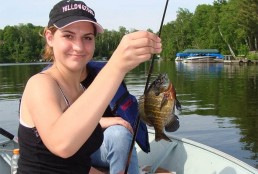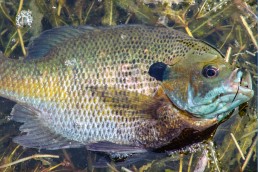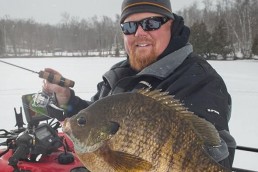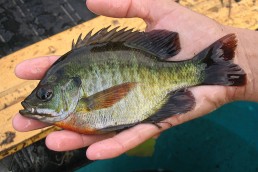Birchwood’s Summertime Bluegills
SHARE THIS POST
It was something every bluegill fisherman dreams about: As soon as I could get my bait back in the water, my bobber would almost instantly disappear—another fish had taken the bait. I set the hook and felt the satisfying weight of another big bluegill on the line–this was amazing.
My dad was also in the boat, and he could hardly keep his line in the water either. The bluegill fishing was absolutely on fire. Most expect this kind of action during the spring spawn, but this was mid-July.
I boated my fish and dropped it into the basket at the side of the boat. It was just shy of 9 inches long and was not even the biggest catch of the day. Dad reached over and added his catch to the basket too. We both just smiled at each other—this was fun. Then, I made another cast and instantly hooked yet another chunky bluegill.
The basket was quickly becoming crowded with all the bluegills we were catching, and we knew we were getting close to our limit of 25 each and that a fish count would be needed soon.
It was another great day on the water in the beautiful Northwoods of Wisconsin.
Dad and I were fishing Red Cedar Lake, one of the Birchwood-area lakes in northwest Wisconsin. Red Cedar is located only a few miles from the town of Birchwood, and the bluegill fishing here is usually great. They were certainly cooperating with us on that day so we began to make plans for a family fish fry.
Birchwood and its lakes are known as the “Bluegill Capital of Wisconsin.” The village is located 20 minutes northeast of the town Rice Lake on Route 48. It’s hard to miss because a 14-foot-tall statue of a bluegill greets visitors as they drive into town. Red Cedar Lake is just southwest of Birchwood, and home to a tremendous population of sunfish. This 1,841-acre lake produces some real dandies throughout the warm-weather months. Bluegills up to 8 inches are common, with lots of 9-inch fish and larger out there too.
Are you enjoying this post?
You can be among the first to get the latest info on where to go, what to use and how to use it!
Like most lakes in the area, Red Cedar is cold and clear. There’s tremendous diversity in this lake’s habitat, making it a real bluegill factory. There are weedy coves with silt bottoms, rocky shorelines, steep drop-offs, shallow bays, areas with huge beds of lily pads and many weedlined flats. The bluegills have plenty to eat, which helps them grow to such large sizes. Besides an abundance of aquatic insects and zooplankton, there are also lots of smaller fish, flying insects, leeches and millions of small crayfish.
Just northeast of Birchwood is Big Chetac Lake. This lake covers 1,920 acres and produces lots of hand-sized bluegills every year. Big Chetac is quite a bit shallower than Red Cedar, but the large surface area gives fishermen plenty of opportunities to chase bluegills in the shallows, even in summer. The extensive weed beds and flats, shallow bays and small points provide lots of places for the resident bluegills to hide.
Between Big Chetac and Red Cedar is the much smaller Birch Lake. Birch may be less for surface area, but it is an extremely deep lake. The maximum depth here is 73 feet. The average depth is 24 feet, so it does not have nearly as much shallow water habitat as Chetac. Locals often fish for walleyes on Birch, but bluegills are also sought here. Most fish for bluegills along the shallower shorelines and in the small weedy bays and coves.
The last two lakes on the list are Hemlock and Balsam. These two lakes are actually connected to Red Cedar Lake, with Balsam located at the north end of Red Cedar and Hemlock just to the south. They are both connected to the main lake via small channels and both are home to slab-sized bluegills. Balsam covers 295 acres and is relatively deep (49 feet max), and since it has good weed growth the bluegills can be quite good. At 357 acres, Hemlock Lake is larger than Balsam, but it is only 21 feet deep at its deepest spot. Extensive shallow, weedy flats and other structure provide good bluegill habitat. Some anglers head for these two lakes to escape the boat traffic on Red Cedar on the weekends.
There are other fishing lakes associated with the town of Birchwood, but it’s hard to justify driving to more distant lakes when there is so much good fishing right on the doorstep of the town.
For more information about Birchwood and fishing in the nearby lakes, check out birchwoodwi.com. You may want to plan your visit to coincide with Annual Bluegill Festival.
MWO
SHARE THIS POST
Did you enjoy this post?
You can be among the first to get the latest info on where to go, what to use and how to use it!
Tom Berg
A lifelong outdoorsman and award-winning outdoor writer and nature photographer, Tom Berg has been the Executive Director/Treasurer of the Hoosier Outdoor Writers group for the past 14 years. When he is not writing, he would rather be outside fishing, hunting or trapping than doing just about anything else.




